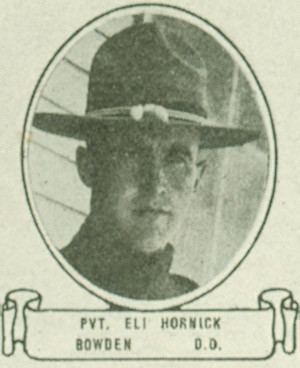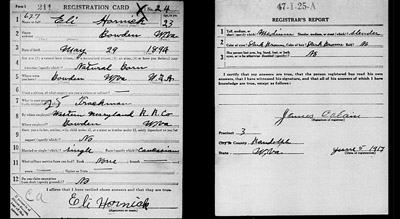

Remember...
Eli Hornick
1894-1918
"Our obligations to our country never cease but with our lives."
John Adams
 |
Remember...Eli Hornick
|
Squire Hornick was a farm laborer and the father of nine sons and one daughter. The family consisted of Adam John, Jesse Clay, Dellis, Grover Cleveland, Eli, Dorsey V., Mason, Preston, Edward, Dan Guy, and Mable Gladys (who died young).
Eli's mother, Melvina Myers Hornick, died from tuberculosis and a stomach ulcer in 1916. Following the death of his wife, Squire Hornick made his home with his son Grover until his death in 1929. Both parents are buried in the Taylor Cemetery at Bowden.
Eli registered in Randolph County for the initial World War One draft on June 5, 1917. At that time, he stated that he resided in Bowden and was single and employed by the Western Maryland Railway Company as a trackman. He claimed no exemptions to the draft. His registration card indicates he was of medium height and slender build with dark brown hair and dark brown eyes.

World War I draft registration for Eli Hornick. National Archives and Records Administration
When called into service, Private Eli Hornick was assigned to Company B of the 313th Machine Gun Battalion, which was part of the 155th Field Artillery Brigade. The 313th, 314th, and 315th Field Artillery units were composed of men almost exclusively from the state of West Virginia and made up the 155th Field Artillery Brigade. The 155th, the 159th Brigade Infantry, and the 160th Brigade Infantry made up the 80th U.S. Army Reserve Division, known as the "Blue Ridge Division." Most of the men in the division were from Pennsylvania, Virginia, and West Virginia. The 80th U.S. Army Reserve Division participated in the First Battle of the Somme, the St. Mihiel Offensive, and the Meuse-Argonne Offensive.
In the St. Mihiel Offensive, which took place from September 12 through 15, 1918, the objective of the battle was four-fold: 1. To deprive the Germans of the St. Mihiel salient; 2. To prevent them from interrupting traffic on the Paris-Nancy Railroad by artillery fire; 3. To free the railroad leading north through St. Mihiel to Verdun; and 4. To provide the Allies with a base of departure for an attack against the Metz-Sedan Railroad system, vital to the German armies west of Verdun, and against the Briey Iron Basin, which was necessary for the production of German armament and munitions. The Battle of St. Mihiel was the first strictly American offensive of the war. In previous engagements, American forces were joined by British, Italian, and French units. They were protected by the largest concentration of Allied air power ever assembled during the war. The successful American forces suffered only 7,000 casualties during the St. Mihiel Offensive, far fewer than expected.
The 155th was the only outfit that saw combat in all three phases of the Meuse-Argonne Offensive, which commenced on September 26, 1918. The objective of this campaign was to repel the Germans eastward from the Hindenburg Line to deny them access to important rail lines supplying the German front. Thirty-seven French and U.S. divisions were opposed by 24 German divisions. By early October, the German Army was exhausted, demoralized, and plagued with an influenza outbreak.
The battle, which lasted until the armistice on November 11, was the largest in U. S. military history. It was also one of the bloodiest battles in U.S. history. More than 95,000 American soldiers were wounded and over 26,000 killed. The 80th Division suffered 6,029 casualties (880 killed in action and 5,149 wounded).
Pvt. Eli Hornick died in a French hospital on October 19, 1918, a victim of pneumonia, in all probability as a result of a mustard gas attack by the Germans. Fatalities from exposure to mustard gas primarily resulted from secondary broncho-pneumonia. Fatally injured victims sometimes took four or five weeks to die of mustard gas exposure.
During the war, the remains of some soldiers were buried several times:first in battlefield graves, then in U.S. cemeteries in Europe, and finally in the United States. At the conclusion of the war, France resisted removing bodies for reburial, but in 1920 the French agreed to the return of American soldiers to the United States. The remains of 46,000 war dead were returned to the U.S. at a cost of over $30 million.
Article prepared by Leon Armentrout
March 2015

West Virginia Archives and History welcomes any additional information that can be provided about these veterans, including photographs, family names, letters and other relevant personal history.